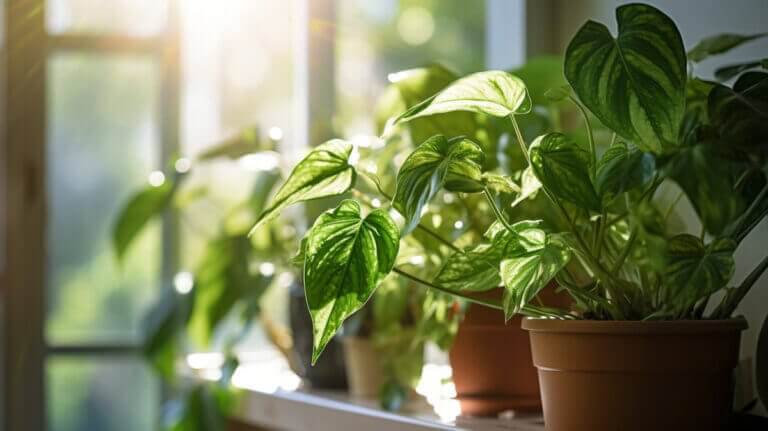How To Grow And Care For A Christmas Cactus Plant: A Beginner’s Christmas Cactus Care Guide
Welcome to my beginner’s guide on growing and caring for Christmas cactus plants. Whether you’re new to gardening or just looking for some tips on how to care for your Christmas cactus houseplant, you’ve come to the right place. In this guide, we’ll explore everything from the basics of caring for these beautiful plants to troubleshooting common issues. So, let’s dive in and learn how to keep your Christmas cactus indoor plant healthy and thriving!
Key Takeaways:
- Christmas cactus, scientifically known as Schlumbergera bridgesii, are perennial succulents that bloom in shades of red, purple, peach, and white.
- These plants require well-drained soil and thrive in partial sun.
- Proper watering is essential to avoid issues like root rot. Water when the top inch of soil is dry, and avoid overwatering.
- Provide the right amount of indirect sunlight and maintain a temperature range of 18-24°C for optimum growth.
- Choose a well-draining soil mix and a pot with drainage holes for your Christmas cactus.
The Importance of Proper Watering for Christmas Cactus Plants
When it comes to caring for your Christmas cactus, proper watering is key to ensuring its health and longevity. Understanding the water needs of these unique plants can help prevent issues such as overwatering, root rot, and dry soil.
Christmas cactus, like many succulents, prefer well-drained soil. It’s important to water them when the top inch of soil feels dry to the touch. This helps prevent waterlogging and allows the roots to breathe.
Overwatering can be detrimental to Christmas cactus, leading to root rot and other problems. To avoid this, make sure the soil is not constantly wet and that excess water can drain freely from the pot.
Watering Schedule for Christmas Cactus Plants
Establishing a watering schedule can ensure that your Christmas cactus receives the right amount of moisture. It’s generally recommended to water these plants every 1-2 weeks during the growing season (spring and summer) and reduce watering in the dormant period (fall and winter).
| Season | Watering Frequency |
|---|---|
| Spring and Summer | Every 1-2 weeks |
| Fall and Winter | Reduce watering |
Providing the Right Light and Temperature for Christmas Cactus Plants
When it comes to caring for your Christmas cactus, providing the right amount of light and maintaining the proper temperature is essential for its wellbeing. These tropical plants thrive in indirect sunlight, so it’s important to find a balance between light and shade. Direct sunlight can cause the leaves to burn, while insufficient light can result in stretched growth and faded leaf color.
For optimal growth, aim to keep your Christmas cactus in a location that receives bright but indirect light. A south-facing window with a sheer curtain or an east-facing window with morning sun is ideal. If you notice the leaves turning pale or yellow, it may be an indication that the plant is receiving too much light.
In terms of temperature, Christmas cactus prefer a range of 18-24°C. Avoid exposing the plant to extreme temperatures or sudden fluctuations, as this can cause stress and hinder its growth. Keep in mind that these plants are native to the Brazilian rainforest, where they enjoy a warm and consistent climate.
If the room temperature drops below 15°C, it may affect the plant’s blooming cycle. To encourage flower production, maintain a temperature range within the suggested range and avoid placing the cactus near drafts, air conditioning vents, or heating sources.
The Right Balance is Key
Providing the right amount of light and maintaining the recommended temperature range is crucial for the overall health and growth of your Christmas cactus plants. By ensuring they receive sufficient but indirect sunlight and a suitable temperature, you can enjoy vibrant blooms and a thriving plant throughout the holiday season.
Choosing the Right Soil and Pot for Christmas Cactus Plants
When it comes to growing healthy Christmas cactus plants, choosing the right soil and pot is essential. These plants require well-draining soil to prevent issues like root rot. A cactus potting mix or succulent mix mixed with perlite is ideal for creating a well-draining environment that promotes healthy root growth. The perlite helps improve water drainage and aeration.
In addition to selecting the right soil, it’s important to choose a pot with drainage holes. These holes allow excess water to escape and prevent waterlogged soil, which can lead to root rot and other problems. When repotting your Christmas cactus, choose a pot that is only one size larger than its current pot. This promotes stable growth and prevents the soil from holding excess moisture.
Table: Pot Sizes for Christmas Cactus Repotting
| Current Pot Size | Suggested Pot Size |
|---|---|
| 4-inch | 6-inch |
| 6-inch | 8-inch |
| 8-inch | 10-inch |
It’s important to note that Christmas cactus prefer to be slightly rootbound, so avoid overpotting. If the roots become too crowded and the plant becomes rootbound, you may notice stunted growth and a decrease in blooms. Repotting every two to three years is generally sufficient.
By choosing the right soil and pot for your Christmas cactus, you can ensure that it has the proper conditions for healthy growth. Remember to use a well-draining soil mix, select a pot with drainage holes, and choose a size that allows for slight rootbound growth. With the right care, your Christmas cactus will thrive and reward you with beautiful blooms year after year.
Fertilizing and Propagating Christmas Cactus Plants
When it comes to fertilizing your Christmas cactus, it’s important to follow a proper schedule to promote healthy growth and vibrant blooms. Start by applying a balanced fertilizer every two weeks during the growing season, typically from spring to early fall. This will provide the necessary nutrients for foliage development. As the flowering period approaches, switch to a low nitrogen fertilizer to encourage the formation of flower buds.
In terms of propagation, Christmas cactus can be propagated through cuttings or seeds. Taking cuttings is the most common method and can be done by carefully removing a segment of the stem and allowing it to dry for a day or two. Once dried, place the cutting in a well-draining potting mix and keep it slightly moist until roots develop. Seeds can also be collected from mature Christmas cacti, but they require specific conditions and a longer time to grow into mature plants.
Creating a humid environment is beneficial for Christmas cactus, as they are native to tropical regions. One way to increase humidity is through misting the plant regularly. Simply spray a fine mist of water over the plant, taking care to avoid overwatering. Another method is to place the potted Christmas cactus on a pebble tray filled with water. The evaporation from the water will create a humid microclimate around the plant, supporting healthy growth and rooting.
Table: Fertilizing Schedule for Christmas Cactus
| Month | Fertilizer Type | Frequency |
|---|---|---|
| Spring to early fall | Balanced fertilizer | Every two weeks |
| Late fall to winter | Low nitrogen fertilizer | Every four weeks |
Common Issues and Troubleshooting for Christmas Cactus Plants
When caring for Christmas cactus plants, it’s important to be aware of common problems that can arise. Pests such as mealybugs, spider mites, and aphids can infest these plants, causing damage to the leaves and stems. Regularly inspect your plants for any signs of these pests, and if detected, take appropriate measures to eliminate them. There are various organic and chemical treatments available to help control these pests.
Another issue that may occur is wilting and yellowing of the leaves, which can be caused by overwatering or underwatering. Finding the right balance is crucial to maintain the plant’s health. Additionally, stunted growth can be a result of inadequate light or improper soil conditions. Ensure your Christmas cactus receives the right amount of indirect sunlight and is planted in well-draining soil to promote healthy growth.
Fungal diseases, such as stem rot, can also affect Christmas cactus plants. These diseases often occur as a result of overwatering or poor air circulation. To prevent fungal infections, avoid wetting the foliage and ensure proper ventilation around the plant. If stem rot is detected, remove the affected parts immediately to prevent further spread.
Avoiding Bud Drop
One common issue that many Christmas cactus owners face is bud drop. This occurs when the plant fails to form flower buds, leading to a lack of blooms during the holiday season. Bud drop can be caused by various factors, including sudden changes in temperature or humidity. To avoid bud drop, it’s important to maintain a consistent environment for your Christmas cactus. Avoid placing the plant near drafts or heat sources, and provide consistent temperature and humidity levels.
By being aware of these common problems and troubleshooting techniques, you can ensure your Christmas cactus stays healthy and vibrant. Regular monitoring, proper care, and prompt action when issues arise will help your plant thrive and bring joy to your home during the holiday season.
FAQ
How can I make my Christmas cactus bloom?
To make your Christmas cactus bloom, it’s important to provide it with a period of darkness for at least 12-14 hours a day for about six weeks. This will encourage the plant to set buds. Also, keep the plant in a cool room with a temperature of about 50-55°F during this period. After the buds appear, you can bring the plant back into bright light and resume normal care.
What are some tips for Christmas cactus care?
Christmas cacti are easy to care for. They prefer bright but indirect light. Avoid placing them in direct sunlight as it can burn the leaves. They need well-draining soil, so a mixture of potting soil and perlite works well. Water the plant when the top inch of soil feels dry to the touch. During the growing season, you can feed it with a balanced houseplant fertilizer.
When and how should I prune my Christmas cactus?
Pruning a Christmas cactus can promote new growth and make the plant bushier. The best time to prune is in late spring or early summer after it has finished blooming. To prune, simply pinch off a few sections of each stem at the joint.
What level of humidity does a Christmas cactus need?
Christmas cacti prefer a higher humidity level than many other houseplants. You can increase humidity by placing the pot on a tray filled with pebbles and water, or by using a humidifier.
How often should I fertilize my Christmas cactus?
During the growing season, from early spring to early fall, you can fertilize your Christmas cactus every 2-4 weeks. Use a balanced houseplant fertilizer and follow the package instructions for how much to use.
How can I propagate a Christmas cactus?
Propagating a Christmas cactus is easy. Simply take a cutting of about three segments, let it dry out for a few days, then plant it in a pot with well-draining soil. Keep the soil slightly moist, and the cutting should start to grow roots within a few weeks.
How often should I water a Christmas cactus?
Watering needs can vary depending on the time of year and the humidity in your home. Generally, you should water your Christmas cactus when the top inch of soil feels dry to the touch. However, it’s important not to overwater, as this can lead to root rot.
How can I get my Christmas cactus to flower?
Getting a Christmas cactus to flower involves manipulating the light and temperature conditions to mimic the natural winter environment of the plant. This includes providing the plant with long nights (at least 13 hours of darkness) and cool temperatures (50-55°F) for about six weeks. After this period, the plant should start to set buds.







